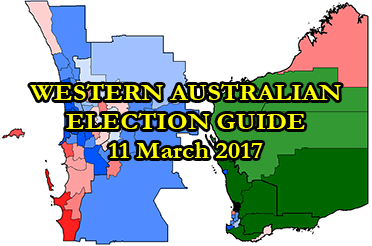Introducing the Poll Bludger’s seat-by-seat guide to the March 11 state election. Also featured: some as-yet-unpublished statewide polling results.
First and foremost, my attractively appointed seat-by-seat guide to the Western Australian state election is now open for business. Featured are detailed overviews of all 59 lower house seats plus interactive booth results maps and past election result charts. An upper house guide will follow in due course, God willing.
Also:
• I can exclusively (I think) reveal that an Essential Research automated phone poll, conducted for the Greens from January 28 to February 5 from a sample of 4282, gave the following results on lower house voting intention: Liberal 27.5%; Nationals 6.8%; Labor 34.5%; One Nation 13.7%; Greens 10.7%; others 7.0%. My rule-of-thumb preference assumptions, in which the Liberals get 75% of Nationals preferences, 20% of Greens preferences and 60% of everything else, point to a Labor two-party lead of 53-47. The poll also has the following numbers for upper house voting intention: Liberal 27.1%; Nationals 5.8%; Labor 34.5%; One Nation 13.7%; Greens 12.4%; others 6.1%.
• The West Australian today reports that the ReachTEL poll it published on Saturday also finds 54.6% opposed to the Liberals’ plan to privatise 51% of Western Power compared with 28.9% in favour, a slightly worse result than the 52.9% and 32.4% recorded a month ago. The poll also finds 43.5% rate the Liberals the most trusted party to restore the state’s finances, with a further 13.7% opting for the Nationals, compared with 42.8% for Labor.
• The headline voting intention result from said ReachTEL poll – a tie on two-party preferred, based on a preference flow that seemed generous to Labor – has been met with widespread skepticism. As former Labor leader Eric Ripper noted in The West Australian yesterday, “a better indication of the anti-government swing comes from John Howard’s campaign itinerary – Kalamunda (10.3%), Southern River (10.9%) and Jandakot (18.3%)”. By contrast, the swing implied by the ReachTEL poll was a little over 7%.
• Pre-poll voting began yesterday, which among other things means parties have to start putting their money where their mouths are with respect to preference deals. The West Australian reports today that Labor is putting the Liberals ahead of the Nationals, and the Liberals and Nationals are directing second preferences to each other, contrary to their upper house tickets.
• Watch this space for a lot more on upper house preference tickets, but for the time being, I had a paywalled Crikey article on the matter last Thursday:
Following the deadline for lodgement of group voting tickets on Monday, it has emerged that five particular parties are privy to an arrangement in which each gets the second preference of the others in one of the state’s six six-member regions … The beneficiaries include self-explanatory concerns called Fluoride Free WA and the Daylight Savings Party, who could respectively harvest the votes of all five parties in the East Metropolitan and South Metropolitan regions — together with those of Julie Matheson for Western Australia, whose well-funded campaign has run to full-page ads in The West Australian. If that’s enough to push them ahead of One Nation or the Greens, they will then receive those parties’ preferences as well — in which case they could hardly fail to get elected. Also in on the deal is Flux the System, whose call for a new age of direct democracy made little impression when they ran in every state for the Senate last year … The other two names involved are more familiar — Family First and the Liberal Democrats, which respectively have the inside running in the North Metropolitan and Agricultural regions.
 Not a moment too soon, you may now find (hopefully) an expanded Western Australian election guide herewith, featuring a comprehensive overview page and a region-by-region guide to the upper house, in addition to the long-established seat-by-seat guide to the lower house. To pre-empt your complaints: a) the site is playing up and you may intermittently find yourself encountering 404 errors, b) the map embeds may not be firing on all cylinders, and c) parts of the upper house guide could suffer more careful proof-reading. The first of these should resolve itself as the day progresses, and the second and third I’ll hopefully maybe have time to attend to at some point.
Not a moment too soon, you may now find (hopefully) an expanded Western Australian election guide herewith, featuring a comprehensive overview page and a region-by-region guide to the upper house, in addition to the long-established seat-by-seat guide to the lower house. To pre-empt your complaints: a) the site is playing up and you may intermittently find yourself encountering 404 errors, b) the map embeds may not be firing on all cylinders, and c) parts of the upper house guide could suffer more careful proof-reading. The first of these should resolve itself as the day progresses, and the second and third I’ll hopefully maybe have time to attend to at some point.